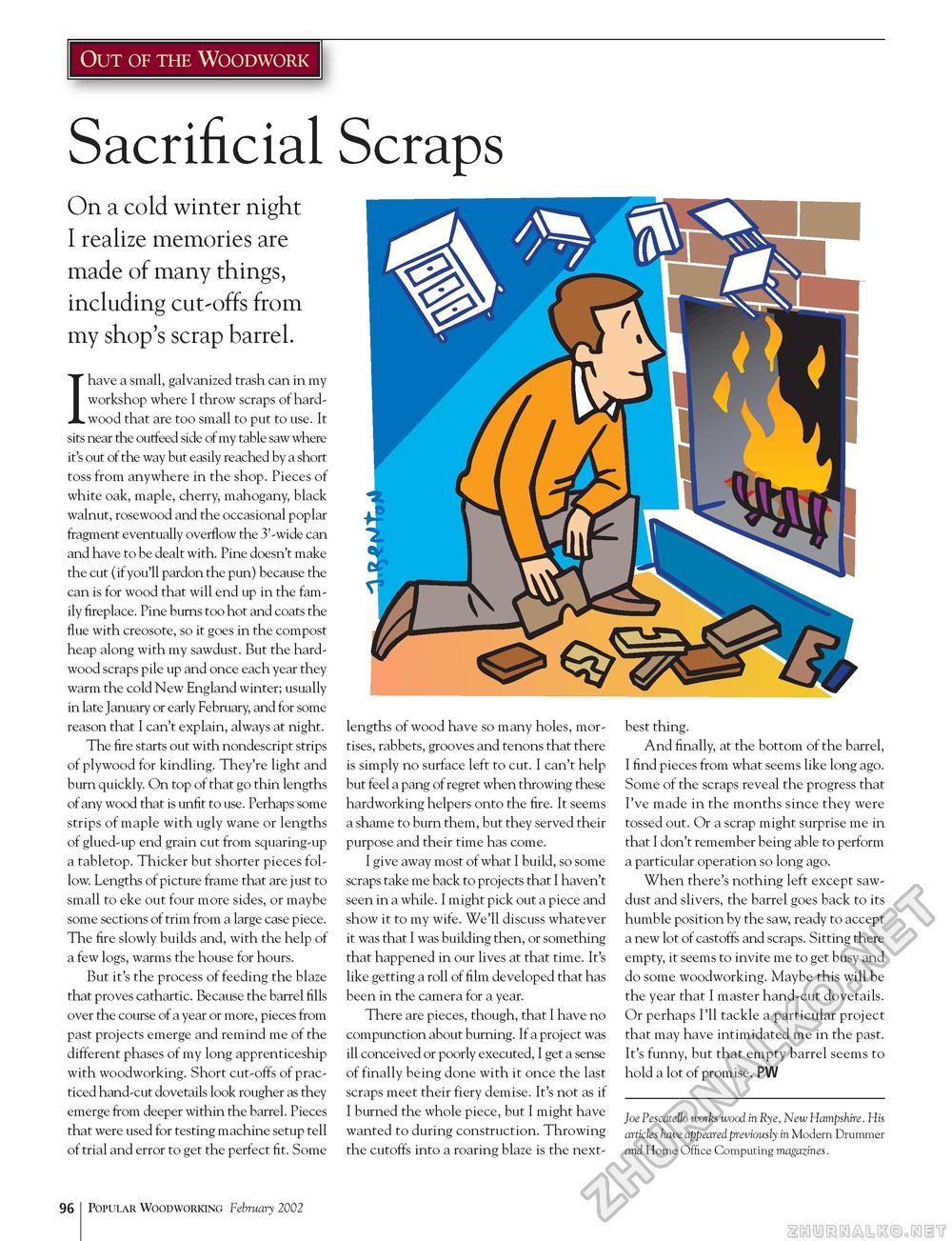Popular Woodworking 2002-02 № 126, страница 97
Out of the Woodwork Sacrificial Scraps On a cold winter night I realize memories are made of many things, including cut-offs from my shop's scrap barrel. Ihave a small, galvanized trash can in my workshop where I throw scraps of hardwood that are too small to put to use. It sits near the outfeed side of my table saw where it's out of the way but easily reached by a short toss from anywhere in the shop. Pieces of white oak, maple, cherry, mahogany, black walnut, rosewood and the occasional poplar fragment eventually overflow the 3'-wide can and have to be dealt with. Pine doesn't make the cut (if you'll pardon the pun) because the can is for wood that will end up in the family fireplace. Pine burns too hot and coats the flue with creosote, so it goes in the compost heap along with my sawdust. But the hardwood scraps pile up and once each year they warm the cold New England winter; usually in late January or early February, and for some reason that I can't explain, always at night. The fire starts out with nondescript strips of plywood for kindling. They're light and burn quickly. On top of that go thin lengths of any wood that is unfit to use. Perhaps some strips of maple with ugly wane or lengths of glued-up end grain cut from squaring-up a tabletop. Thicker but shorter pieces follow. Lengths of picture frame that are just to small to eke out four more sides, or maybe some sections of trim from a large case piece. The fire slowly builds and, with the help of a few logs, warms the house for hours. But it's the process of feeding the blaze that proves cathartic. Because the barrel fills over the course of a year or more, pieces from past projects emerge and remind me of the different phases of my long apprenticeship with woodworking. Short cut-offs of practiced hand-cut dovetails look rougher as they emerge from deeper within the barrel. Pieces that were used for testing machine setup tell of trial and error to get the perfect fit. Some lengths of wood have so many holes, mortises, rabbets, grooves and tenons that there is simply no surface left to cut. I can't help but feel a pang of regret when throwing these hardworking helpers onto the fire. It seems a shame to burn them, but they served their purpose and their time has come. I give away most of what I build, so some scraps take me back to projects that I haven't seen in a while. I might pick out a piece and show it to my wife. We'll discuss whatever it was that I was building then, or something that happened in our lives at that time. It's like getting a roll of film developed that has been in the camera for a year. There are pieces, though, that I have no compunction about burning. If a project was ill conceived or poorly executed, I get a sense of finally being done with it once the last scraps meet their fiery demise. It's not as if I burned the whole piece, but I might have wanted to during construction. Throwing the cutoffs into a roaring blaze is the next- best thing. And finally, at the bottom of the barrel, I find pieces from what seems like long ago. Some of the scraps reveal the progress that I've made in the months since they were tossed out. Or a scrap might surprise me in that I don't remember being able to perform a particular operation so long ago. When there's nothing left except sawdust and slivers, the barrel goes back to its humble position by the saw, ready to accept a new lot of castoffs and scraps. Sitting there empty, it seems to invite me to get busy and do some woodworking. Maybe this will be the year that I master hand-cut dovetails. Or perhaps I'll tackle a particular project that may have intimidated me in the past. It's funny, but that empty barrel seems to hold a lot of promise. PW Joe Pescatello works wood in Rye, New Hampshire. His articles have appeared previously in Modern Drummer and Home Office Computing magazines. 96 Popular Woodworking February 2002 |







